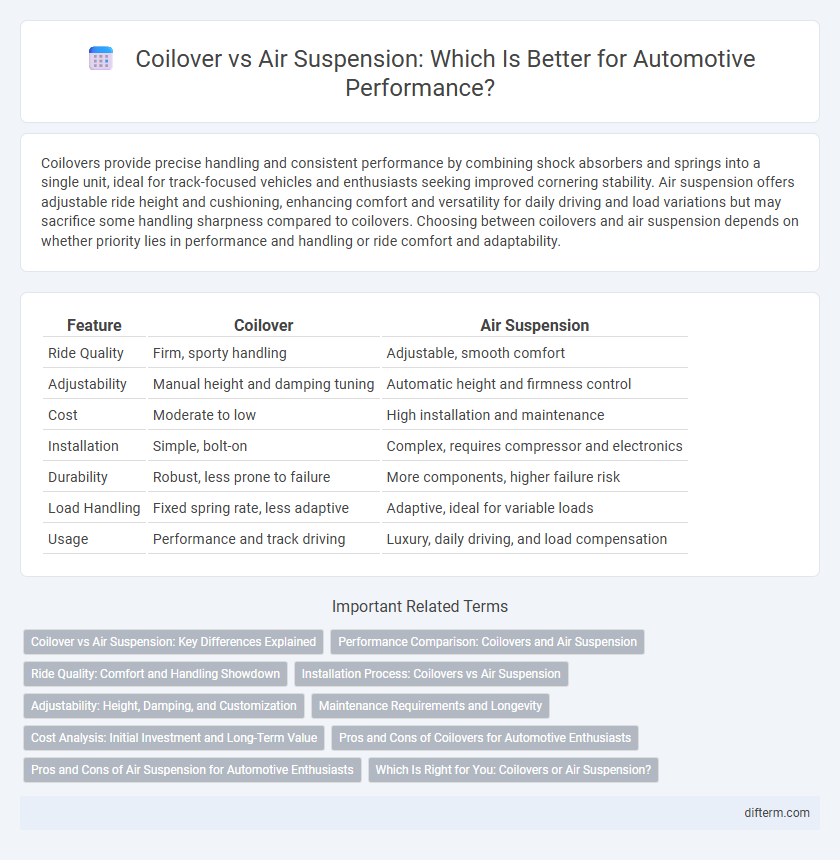Coilovers provide precise handling and consistent performance by combining shock absorbers and springs into a single unit, ideal for track-focused vehicles and enthusiasts seeking improved cornering stability. Air suspension offers adjustable ride height and cushioning, enhancing comfort and versatility for daily driving and load variations but may sacrifice some handling sharpness compared to coilovers. Choosing between coilovers and air suspension depends on whether priority lies in performance and handling or ride comfort and adaptability.
Table of Comparison
| Feature | Coilover | Air Suspension |
|---|---|---|
| Ride Quality | Firm, sporty handling | Adjustable, smooth comfort |
| Adjustability | Manual height and damping tuning | Automatic height and firmness control |
| Cost | Moderate to low | High installation and maintenance |
| Installation | Simple, bolt-on | Complex, requires compressor and electronics |
| Durability | Robust, less prone to failure | More components, higher failure risk |
| Load Handling | Fixed spring rate, less adaptive | Adaptive, ideal for variable loads |
| Usage | Performance and track driving | Luxury, daily driving, and load compensation |
Coilover vs Air Suspension: Key Differences Explained
Coilovers provide precise ride height adjustment and superior handling through mechanical spring tension, making them ideal for performance-focused vehicles. Air suspension offers adjustable ride comfort and load leveling by utilizing air springs, enhancing versatility for varying road conditions. Key differences include coilovers' fixed damping with manual tuning versus air suspension's electronically controlled, customizable ride parameters.
Performance Comparison: Coilovers and Air Suspension
Coilovers deliver superior handling precision and consistent ride height adjustment, making them ideal for high-performance driving and track use. Air suspension offers adjustable ride comfort and versatility, allowing drivers to switch between soft daily driving and firm performance settings with ease. Performance-wise, coilovers provide more immediate road feedback and stability, while air suspension excels in adaptive damping and load management for varied driving conditions.
Ride Quality: Comfort and Handling Showdown
Coilovers provide precise handling and a sporty ride by allowing adjustable damping and spring rates, ideal for enthusiasts seeking responsive cornering and stability. Air suspension offers superior ride comfort with its ability to adapt ride height and absorb road imperfections smoothly, enhancing daily drivability and passenger comfort. Choosing between coilovers and air suspension depends on balancing performance-oriented handling preferences versus flexible, cushioned ride quality.
Installation Process: Coilovers vs Air Suspension
Coilover installation typically involves mounting adjustable shock absorbers and springs directly onto the vehicle's suspension, requiring precise alignment and tuning to achieve desired ride height and handling performance. Air suspension systems demand a more complex installation process, including the integration of air compressors, tanks, airbags, and electronic control units, which allows for customizable ride quality and height adjustment on the fly. While coilovers offer a more straightforward mechanical setup with fewer components, air suspension requires advanced electrical wiring and space allocation, making its installation more time-consuming and technically demanding.
Adjustability: Height, Damping, and Customization
Coilovers offer precise manual adjustability, allowing users to fine-tune ride height, damping stiffness, and corner balancing for optimal handling performance. Air suspension systems provide effortless height adjustment via onboard compressors and customizable damping settings controlled through electronic interfaces, enabling quick adaptability to different driving conditions. Both systems support extensive customization, but coilovers excel in mechanical tuning precision, while air suspensions prioritize convenience and versatility in ride dynamics.
Maintenance Requirements and Longevity
Coilovers require regular inspection of springs, dampers, and mounting hardware to ensure optimal performance and prevent premature wear, typically offering longer durability due to fewer components prone to failure. Air suspension systems demand frequent maintenance of airbags, compressors, and air lines, with higher risk of leaks and compressor failure, which can reduce overall lifespan. Proper care and timely replacement of parts significantly influence the longevity of both coilover setups and air suspension kits in automotive applications.
Cost Analysis: Initial Investment and Long-Term Value
Coilover suspension systems generally require a lower initial investment, typically ranging between $1,000 and $3,000, offering durable performance with minimal maintenance costs. Air suspension setups often involve higher upfront expenses, from $3,000 to $8,000 or more, but provide adjustable ride height and comfort, which can enhance vehicle value over time. Long-term costs for coilovers remain low due to fewer electronic components, whereas air suspension may incur higher repair and replacement expenses related to airbags, compressors, and sensors.
Pros and Cons of Coilovers for Automotive Enthusiasts
Coilovers provide automotive enthusiasts with precise adjustable ride height and improved handling due to their rigid spring and damper combination, making them ideal for track performance and spirited driving. They tend to offer better cornering stability and responsiveness compared to air suspension but can result in a stiffer ride that may reduce comfort on daily drives. Installation and maintenance of coilovers require more mechanical knowledge and can be costlier upfront, although they often have greater durability and fewer air-related failures than air suspension systems.
Pros and Cons of Air Suspension for Automotive Enthusiasts
Air suspension offers superior ride comfort and adjustable ride height, allowing automotive enthusiasts to customize their vehicle's stance and handling dynamically. It provides improved load leveling and reduced road vibrations compared to coilover systems, enhancing long-distance driving quality. However, air suspension systems can be more complex, costly to maintain, and prone to leaks or compressor failures, which may pose reliability concerns for performance-focused users.
Which Is Right for You: Coilovers or Air Suspension?
Coilovers provide precise handling and a sportier ride due to adjustable spring rates and damping, making them ideal for performance enthusiasts seeking improved cornering and responsiveness. Air suspension offers superior comfort and versatility with adjustable ride height and adaptability for varying loads, perfect for drivers prioritizing smoothness and customization in daily driving or heavy-duty use. Choosing between coilovers and air suspension depends on your preference for performance tuning versus ride comfort and adaptability.
coilover vs air suspension Infographic

 difterm.com
difterm.com